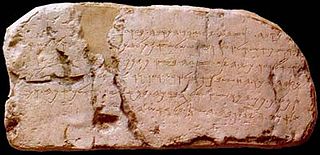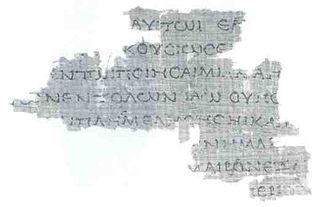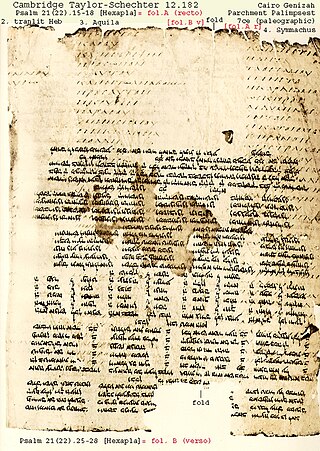Related Research Articles
Jah or Yah is a short form of יהוה (YHWH), the four letters that form the tetragrammaton, the personal name of God: Yahweh, which the ancient Israelites used. The conventional Christian English pronunciation of Jah is, even though the letter J here transliterates the palatal approximant. The spelling Yah is designed to make the pronunciation explicit in an English-language context, especially for Christians who may not use Hebrew regularly during prayer and study.

Biblical Hebrew, also called Classical Hebrew, is an archaic form of the Hebrew language, a language in the Canaanite branch of Semitic languages spoken by the Israelites in the area known as the Land of Israel, roughly west of the Jordan River and east of the Mediterranean Sea. The term "Hebrew" (ivrit) was not used for the language in the Hebrew Bible, which was referred to as שְֹפַת כְּנַעַן or יְהוּדִית, but the name was used in Ancient Greek and Mishnaic Hebrew texts.

Tiberian Hebrew is the canonical pronunciation of the Hebrew Bible (Tanakh) committed to writing by Masoretic scholars living in the Jewish community of Tiberias in ancient Galilee c. 750–950 CE under the Abbasid Caliphate. They wrote in the form of Tiberian vocalization, which employed diacritics added to the Hebrew letters: vowel signs and consonant diacritics (nequdot) and the so-called accents. These together with the marginal notes masora magna and masora parva make up the Tiberian apparatus.

Hexapla, also called Origenis Hexaplorum, is a critical edition of the Hebrew Bible in six versions, four of them translated into Greek, preserved only in fragments. It was an immense and complex word-for-word comparison of the original Hebrew Scriptures with the Greek Septuagint translation and with other Greek translations. The term especially and generally applies to the edition of the Old Testament compiled by the theologian and scholar Origen, sometime before AD 240.

Matthew 5:18 is the eighteenth verse of the fifth chapter of the Gospel of Matthew in the New Testament and is part of the Sermon on the Mount. In the previous verse, Jesus has stated that he came not to destroy the law, but fulfill it. In this verse, this claim is reinforced.
In contrast to the variety of absolute or personal names of God in the Old Testament, the New Testament uses only two, according to the International Standard Bible Encyclopaedia. From the 20th century onwards, "a number of scholars find various evidence for the name [YHWH or related form] in the New Testament.

Theodotion was a Hellenistic Jewish scholar, perhaps working in Ephesus, who in c. 150 CE translated the Hebrew Bible into Greek. Whether he was revising the Septuagint, or was working from Hebrew manuscripts that represented a parallel tradition that has not survived, is debated. In the 2nd century Theodotion's text was quoted in The Shepherd of Hermas and in Justin Martyr's Dialogue with Trypho. His finished version, which filled some lacunae in the Septuagint version of the Book of Jeremiah and Book of Job, formed one column in Origen of Alexandria's Hexapla, c. 240 CE. The Hexapla, now only extant in fragments, presented six Hebrew and Greek texts side-by-side: two Greek versions, by Aquila and Symmachus, and Theodotion's version following it, apparently reflecting a contemporary understanding of their historical sequence.

The Tetragrammaton, or the Tetragram, is the four-letter Hebrew theonym יהוה, the name of God in the Hebrew Bible. The four letters, written and read from right to left, are yodh, he, waw, and he. The name may be derived from a verb that means "to be", "to exist", "to cause to become", or "to come to pass". While there is no consensus about the structure and etymology of the name, the form Yahweh is now accepted almost universally, though the vocalization Jehovah continues to have wide usage.
Greek orthography has used a variety of diacritics starting in the Hellenistic period. The more complex polytonic orthography, which includes five diacritics, notates Ancient Greek phonology. The simpler monotonic orthography, introduced in 1982, corresponds to Modern Greek phonology, and requires only two diacritics.

The English Hexapla is an edition of the New Testament in Greek, along with what were considered the six most important English language translations in parallel columns underneath, preceded by a detailed history of English translations and translators by S. P. Tregelles; it was first published in 1841. The six English language translations provided are Wycliffe's (1380), William Tyndale's (1534), Cranmer's, the Geneva Bible (1557), Rheims (1582), and the Authorised version, or King James Bible (1611), arranged in columns underneath.

Sacred Name Bibles are Bible translations that consistently use Hebraic forms of the God of Israel's personal name, instead of its English language translation, in both the Old and New Testaments. Some Bible versions, such as the Jerusalem Bible, employ the name Yahweh, a transliteration of the Hebrew tetragrammaton (YHWH), in the English text of the Old Testament, where traditional English versions have LORD.
The Syro-Hexaplar version is the Syrian Aramaic (Syriac) translation of the Greek of the Septuagint as found in the fifth column of Origen's Hexapla. The translation was made by Bishop Paul of Tella at the monastery of the Enaton in Egypt around 617.
Biblical Hebrew orthography refers to the various systems which have been used to write the Biblical Hebrew language. Biblical Hebrew has been written in a number of different writing systems over time, and in those systems its spelling and punctuation have also undergone changes.

The Babylonian vocalization, also known as Babylonian supralinear punctuation, or Babylonian pointing or Babylonian niqqud Hebrew: נִקּוּד בָּבְלִי) is a system of diacritics (niqqud) and vowel symbols assigned above the text and devised by the Masoretes of Babylon to add to the consonantal text of the Hebrew Bible to indicate the proper pronunciation of words, reflecting the Hebrew of Babylon. The Babylonian notation is no longer in use in any Jewish community, having been supplanted by the sublinear Tiberian vocalization. However, the Babylonian pronunciation as reflected in that notation appears to be the ancestor of that used by Yemenite Jews.

The manuscript 4Q120 is a Septuagint manuscript (LXX) of the biblical Book of Leviticus written on papyrus, found at Qumran. The Rahlfs-No. is 802. Paleographically it dates from the first century BCE. Currently the manuscript is housed in the Rockefeller Museum in Jerusalem.

The ms. Ambrosiano O 39 sup. – is a manuscript of the Hexapla of Origen dated to the late ninth century C.E. written in a codex form. This is a palimpsest, meaning that the current text is written on leaves which had been written on before and cleaned.
The Papyrus Vindobonensis Graecus 39777 signed as SymP.Vindob.G.39777 – is a fragment of a Greek manuscript of the Psalms of the translation of Symmachus. It was written in papyrus in a scroll form. The papyrus contains fragments of Psalm 69 and Psalm 81. The P.Vindob.G.39777 is dated to late third century or beginning fourth century AD.

Papyrus Oxyrhynchus 5101, designated by 2227, or P.Oxy.77 (LXXVII) 5101, is a manuscript of the Greek Septuagint Psalms, written on papyrus in roll form. It has survived in a very fragmentary condition. Using the study of comparative writings styles (palaeography), it has been dated to the middle of the first - middle of the second century CE.

The AqBurkitt are fragments of a palimpsest containing a portion of the Books of Kings from Aquila's translation of the Hebrew bible from the 6th century, overwritten by some liturgical poems of Yanai dating from the 9–11th century. This Aquila translation was performed approximately in the early or mid-second century C.E. The manuscript is variously dated to the 6th-century CE, or 5th-6th century CE.

The siglum Taylor-Schechter 12.182 designates a manuscript written on parchment in codex form. This is a palimpsest of a copy of Origen's work called the Hexapla. The manuscript is dated to 7th-century AD, and is the oldest of the hexapla manuscripts. The hexapla was completed before 240 CE.
References
- ↑ Janssens (1982 :11–12)
- 1 2 3 4 Janssens (1982 :13)
- 1 2 Janssens (1982 :14)
- 1 2 3 Janssens (1982 :38–39)
- 1 2 Janssens (1982 :39–40)
- ↑ Janssens (1982 :40)
- ↑ Janssens (1982 :54)